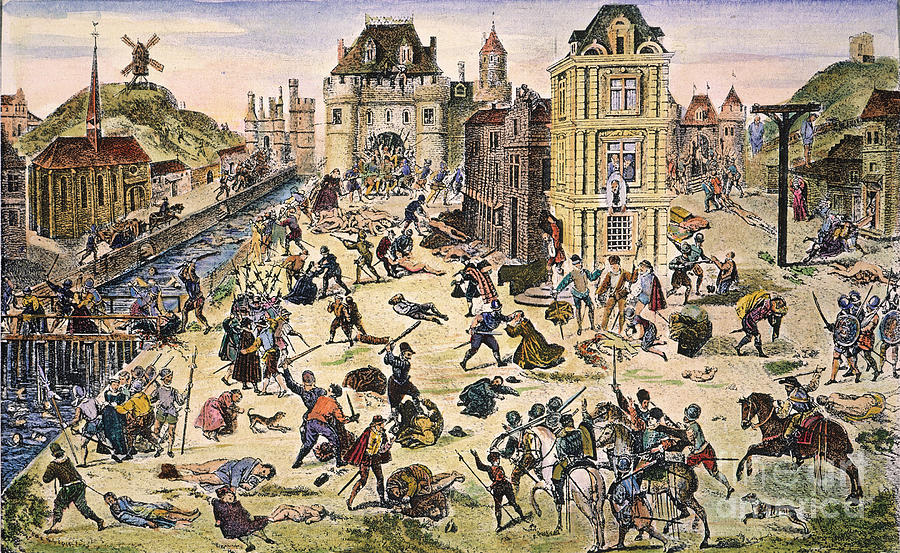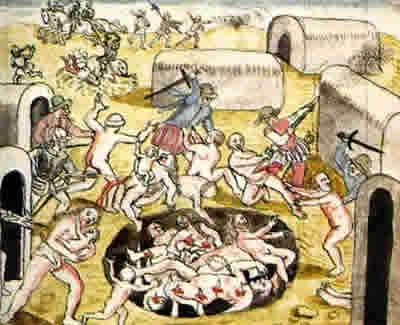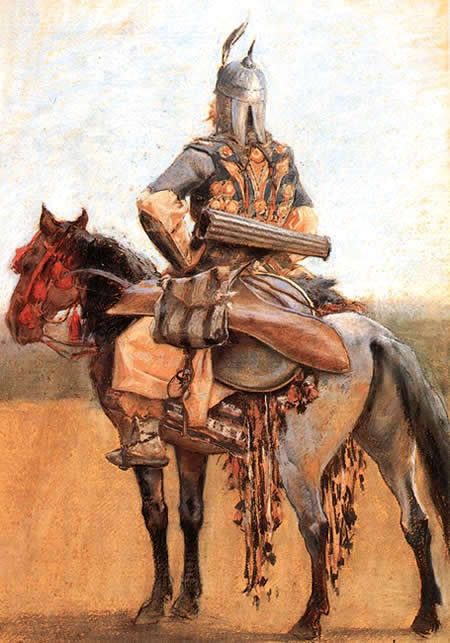 |
| Conquest and Colonization of Brazil |
The
Portuguese conquest of Brazil was a complex, prolonged, and partial process that many scholars argue was never fully realized. Lacking large cities, a centralized political structure, and a common language, the estimated 2 to 3 million precontact indigenous inhabitants of the Brazilian coast and interior were divided into an intricate patchwork of ethnolinguistic groups and clan-based tribes.
The principal coastal groups were Tupi-speaking peoples who had migrated into the area in the preceding centuries, displacing and absorbing existing groups. Seminomadic hunter-gatherers with intimate knowledge of the local environment, Tupi speakers were divided into numerous major branches and hundreds of autonomous bands, often in conflict with each other and other groups, and possessing great skill in the arts of war.
Their principal weapon, often used with deadly effect, was the bow and arrow. Like other ethnolinguistic groups in the Americas, many Tupi-speaking peoples practiced ritual cannibalism in the most general terms, a cultural-religious practice acknowledging the spiritual power of slain enemies.
The Portuguese used reports of ritual cannibalism to justify their invasion, slave raiding, and other excesses of violence, much as the Spanish had used the practice of ritual human sacrifice to justify their subjugation of the Aztecs in the
conquest of Mexico.
The first European explorer to sight the Brazilian coast was Portuguese noble Pedro Álvares Cabral, in command of 13 ships headed around the southern tip of Africa to India, on April 22, 1500. Following a brief excursion on the beach, the expedition’s chronicler, Pêro Vaz de Caminha, produced the first written report on the land and its people.
Cabral sent one ship back to Portugal loaded with brazilwood, a red dyewood from which the later colony derived its name, and left behind two convicts to begin the process of mixing with the natives. The following year Florentine explorer
Amerigo Vespucci sailed along Brazil’s southern coast. A number of French and Spanish expeditions followed.
These initial contacts with the natives were largely peaceful, though here as elsewhere they resulted in the spread of European diseases against which native peoples had no biological immunity. These diseases led to rapid population declines in many areas long before Europeans arrived.
The years 1500–30 saw the growth of the brazil-wood trade between Europeans and Brazil’s coastal peoples. Relations between rival French and Portuguese traders soon degenerated into a series of violent clashes, with the French ignoring the
Treaty of Tordesillas of 1494, to which it was not a signatory.
In the early 1520s, the Portuguese established a garrisoned trading station at Pernambuco, where sugar cultivation was introduced in 1526. French-Portuguese hostilities along the coast intensified. In 1530, the Portuguese Crown responded by commissioning Martím Afonso de Sousa to begin the process of settlement and
colonization, an expedition that in 1532 established the first permanent colony at São Vicente near modern São Paulo.
As conflicts with the French grew, in the mid-1530s King João III and his advisers devised the donatory system, which divided the coastland into 15 sections or donatories that extended along imaginary boundaries west into the interior, each to be ruled by a captain or hereditary lord.
Entrusting colonization to a handful of private individuals who would exercise full authority within their respective domains, the Crown hoped to secure its claims against its French rivals. Most donatories languished and failed, with São Vicente and Pernambuco seeing the greatest albeit limited
success.
Important in this early phase of colonization were a small number of individuals who mixed with the natives and acted as cultural intermediaries between indigenous peoples and the Portuguese. Sailor Diogo Álvares ventured into the interior near Bahia in the early 1500s, married the daughter of the chief of the Tupinambá tribe, learned their language and culture, and changed his name to Caramurú.
By the 1530s, he had become a respected tribal chieftain and from this position of authority worked to facilitate the process of colonization. That the Bahia captaincy failed was due mainly to poor administration and the settlers’ failure to heed Caramurú’s counsel regarding their interactions with the natives.
Farther south, the settlement of São Paulo succeeded in large part by the efforts of Portuguese castaway João Ramalho, who had also married into a local tribe, the Goiana Tupinikin, and served as interpreter and intermediary.
Portuguese colonists generally mixed with the local inhabitants to a greater extent than was true of other European powers, thereby facilitating subsequent cultural and linguistic melding of different ethnic and racial groups.
Sugar Trade As the brazilwood trade faded, sugar became the colony’s economic backbone. By the mid-1540s, two sugar-producing centers had emerged; one was around Pernambuco in the north, and the other was in São Vicente in the south.
By this time, competition with French, Spanish, and other rivals had sharpened, prompting the Portuguese Crown to intensify colonization efforts. Consequently, the Crown would play a major role in the colony’s economic development.
In 1549, Tomé de Sousa was appointed governor-general of Brazil at the head of a major expedition that included royal officials, artisans, soldiers, and Jesuit missionaries. Sousa established Salvador as the colony’s capital. To the south, the French colony at the Guanabara Bay threatened Portuguese control of the southern littoral.
In 1565–67, the Portuguese defeated and ousted the French colony and established the town São Sebastião de Rio de Janeiro. Sousa’s successor Mem de Sá (governor-general, 1558–74) consolidated royal control over these coastal population centers.
Indigenous resistance to colonization intensified, particularly in consequence of slave-raiding expeditions organized by planters in the rapidly growing sugar industry. Indian counterattacks nearly destroyed the settlements of Bahia, Espirito Santo, and Ilhéus, and killed Brazil’s first bishop, but could not stem the Portuguese tide.
The Jesuits played a key role in this early phase of colonization and in the centralization of royal authority. Though their numbers were never large (110 in all of Brazil in 1574), their economic, social, and cultural impact was huge.
Young and aggressive, the Jesuit order (founded in 1540) was instrumental in establishing the town of São Paulo in 1557, and in facilitating generally peaceful relations between Indians and colonists in the south.
Taking no vow of poverty, Jesuits made their missions (aldeas) self-supporting and profitable through farming, ranching, and related enterprises. They were also crucial to the colony’s educational life. For most of the colonial period, Jesuit colleges in all the major towns served as the colony’s principal schools.
By the mid-1500s, sugar planters considered that labor had become the colony’s principal economic bottleneck. Land was plentiful, but sugar production in their view required a steady and reliable supply of bound labor. Enslaving native peoples was their initial
strategy for meeting these rising labor demands.
The period from 1540 to 1600 saw the most extensive use of Indian slave labor in Brazil’s burgeoning sugar industry. By the late 1500s, disease and native resistance combined to make Indian slavery unable to meet sugar growers’ labor demands, leading to conflicts among the Crown, sugar growers, and the
Jesuits.
The Crown tended to advocate the integration of Indians into the economy as free wage laborers; sugar growers promoted slavery; and Jesuits worked toward the transformation of Indians into a kind of smallholding or peasant class. Whose vision predominated hinged on a host of local and regional variables.
The transition from Indian to African slave labor was gradual, though by the early 1600s African slave labor dominated the sugar industry. The first Africans came as servants and sailors, while the first large-scale importation of African slaves did not begin until the 1570s. By the 1580s, the labor force on the 66 sugar plantations of Pernambuco is estimated at two-thirds Indian and one-third African slaves.
In later decades, the proportion of African slaves grew, so that by 1600 Brazil’s slave labor force was predominantly African. Over the next 250 years, Brazil became the single largest recipient of African slaves in the Americas, especially the Northeast, the colony’s principal sugar zone.
Brazil’s European population remained overwhelmingly concentrated in coastal areas. All the major cities founded in the 1500s were ports, including Bahia, São Vicente, Olinda (1537), Santos (1545), Salvador (1549), Vitória (1551), and Rio de Janeiro (1565). The pattern continued well into the 1600s, especially in the north and along the lower reaches of the Amazon.
The Brazilian population remained heavily concentrated in coastal areas through the colonial period and after. As European coastal populations swelled, migrations of Indian peoples away from the coast intensified, producing a ripple effect throughout the interior.
In 1585, São Paulo colonists officially authorized slave-raiding expeditions, and for the next 150 years the bandeirantes hunted Indian slaves across much of Brazil in the service of Paulista sugar planters. From the 1550s on, a series of epidemics ravaged Indian populations, including those of 1552 around Bahia, 1554 around São Paulo, Espírito Santo in 1559, and continuing through the colonial period.
Further impelling the Portuguese Crown to consolidate its hold on the colony was the Dutch presence in the Northeast, from the 1620s until their expulsion in 1654. The discovery of gold in present-day Minas Gerais in the mid-1690s led to a gold rush in these regions from 1700 to 1760, while discovery of diamonds in the same region in the 1720s further propelled expansion into the interior.
Many escaped African slaves also escaped into the interior, sometimes forming Maroon societies of runaway slaves, called quilombos. The largest and most resilient, Palmares, endured through most of the 1600s. By 1700, the population of the colonized areas was an estimated 300,000, with 100,000 whites, 150,000 mostly African slaves, and 50,000 free blacks, Indians, and mixed-race groups.
Colonial Brazil’s first 250 years set in motion a series of patterns and processes that profoundly shaped the subsequent development of Brazilian society. Especially important in this regard were the formation of an export-oriented economy (most notably brazilwood, sugar, gold, and diamonds); stark divisions of race and class; highly unequal landownership; a substantial degree of racial and ethnic intermingling, particularly among the lower classes; the gradual movement of the frontier of settlement westward; the subordination of Indian and African peoples within a relatively rigid social hierarchy; and the existence of vast unconquered lands beyond the western and northern frontiers.



























